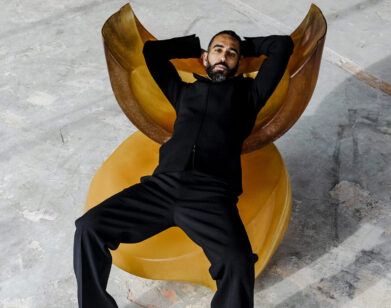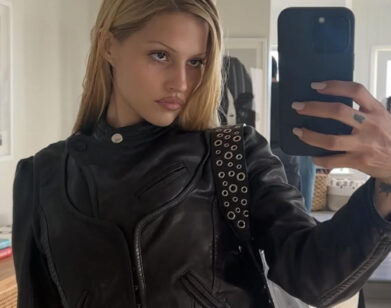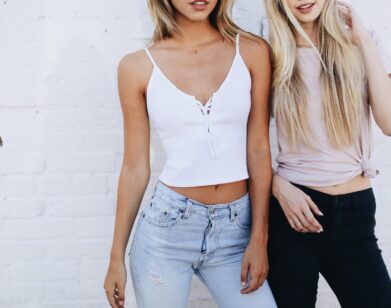Contemporary Couture
Last Sunday, on the first night of the Fall 2014 haute couture schedule in Paris, Stella Tennant closed the Atelier Versace show in something rather unexpected: a glittery, black, body-conscious bodice (very Versace) with a pearly white, floor-length, ball gown-size skirt exploding from its waist (not very Versace). Donatella had chosen the ’50s as the unlikely inspiration for her couture collection this season, and the cross between the old-school glamour of that decade and her own skin-tight, sexed-up aesthetic was a rare sight. The blown-up ballroom volumes were sliced open in the front to show as much leg as possible. Sheer panels here and there in a striped pattern interrupted the collection’s nostalgic silhouettes—puffy sleeves, exaggerated hips, and so on—in a graphic way. The cinched waists that evoked that era’s hourglass ideal were fixed into place with sleek golden clasps and bars (one model’s waist was encased all the way around in a formidable gilded exoskeleton).
It was unpredictable coming from a brand synonymous with straightforward sex appeal and futurism. But it was also pretty prescient in its contradictions, as most of the collections that followed it later in the week showed a similar interest in revisiting the past—more often than not, in an irreverent and inventive way that seemed to herald the arrival of a newer, younger couture client.
Karl Lagerfeld confirmed such an intention at Chanel, where he shared that his starting point for the season was Le Corbusier’s apartment in mid-century Paris. Ever the showman at his Grand Palais défilés, Lagerfeld recreated the apartment down to replicas of its fireplace at either end of the catwalk—though, tellingly, the flames that burned inside them were digital. Considering that Lagerfeld has transplanted real-live forests and icebergs to the palais in recent years, this seemed like less of a matter of production constraints than a statement of his intent to modernize the past. The Corbusier reference yielded a pared down palette of white, black, silver, beige, and gold, and at the heart of every look, from dresses to skirt suits to overcoats, were a pair of embroidered biking shorts. It almost constituted couture sportswear—which seems like a contradiction in terms—but made for an unexpectedly charming (and undeniably young) foundation for the collection. Keeping with the theme, Lagerfeld had taken one of the most utilitarian materials imaginable (and a favorite of Le Corbusier’s), concrete, and broken it into tiny, beautiful beads in the embroidery throughout the collection. The workmanship in the beading was as painstaking as ever, but the overall effect was laid-back and spritely.
At Dior, Raf Simons was less specific in his reference points, but no less steeped in history. In an eight-part collection, he explored the concepts that he thought would have excited him as a designer if he had been born at different points in the past, from the Edwardian era in England to the ’50s in France. His 18th-century-inspired gowns, which blew out into exaggerated, almost abstract bell shapes at his models’ hips, hung like casual cotton tanks on their shoulders. The embroidered overcoats he showed were worn over sharply tailored, wide-legged black slacks, and a series of silk dresses came with zippers up the front and technical-looking belts around the waist. Simons even sent out a set of jumpsuits that drew comparisons to astronaut uniforms. Disparate references notwithstanding, the collection had an airy, uncomplicated unity to it. From the 1700s to outer space in under 60 looks: it was a classic Simons coup.
Like Simons, Valentino’s Maria Grazia Chiuri and Pierpaolo Piccioli took a non-linear approach to the past this season. They were looking back at the Pre-Raphaelites for their fall collection, and the way those artists referenced classical antiquity. This twice-filtered, very rosy gaze on ancient history produced a lovely collection. It had the muted, mostly black and white palette that showed up at Chanel and Dior; a sparse, graphic quality that made Roman artwork feel fresh; and the same flat footwear that lent Lagerfeld’s collection some of its ease. Several dresses came tied at the waist with thick leather straps in big, decorative bows, but they felt makeshift and vaguely martial instead of prim and proper—another touch that kept the collection light even under the weight of all the history it plowed.
There were, however, designers who chose to forgo the past altogether. Bouchra Jarrar’s collection, which showed in the history-heavy courtyard of Paris’s Lycée Henry-IV, was a study in contemporary dressing. Pants outnumbered skirts two to one, and they came in a fluid, green-gray satin with racing stripes in blue, black, and white up the side. On top of those were endless variations on Jarrar’s signature perfecto jackets in a custom-created “mineral tweed,” which glittered like crystal and gave her models the look of intergalactic biker chicks. In between them came supremely simple and easygoing dresses in animal-print silk chiffon that betrayed none of the hours of tedious handwork that went into pleating them.
Alexandre Vauthier has never been weighed down by heritage. His brand is only five years old, and he’s been making very, very sexy clothes for all five of them. He upped the ante this season with a number of dresses that were cut to reveal his models’ backsides in creative ways (a pearl-embroidered band across the cheek was one of them). But that didn’t detract (or distract) from his atelier’s workmanship. It takes expert cutting to keep a dress like that from becoming a bona fide wardrobe malfunction. And an equally racy number—a beaded, red, off-the shoulder dress towards the end of the show—demanded almost 2,000 hours of embroidery.
Red was the only color in sight at Viktor & Rolf. The designers had picked a totally contemporary starting point for their collection: our obsession with the red carpet—which, as it happens, is the only place that most couture creations will ever appear outside of their runway shows. As if to acknowledge that fact, Viktor Horsting and Rolf Snoeren covered their runway in plush red carpeting. And every dress they sent out (they only sent out dresses) was made of the stuff. They’d cut, folded, and shaved the material into oversized variations on two major Hollywood clichés: big bows and leopard prints. They ran the gamut of starlets’ favorite styles, from regal, overworked floor-length dresses to extra simple minis. The material, thick and fluffy and overwhelmingly red, made each look seem slightly heavy and off-kilter. Horsting and Snoeren were definitely interrogating traditional Tinseltown style more than they were celebrating it. Celebrity culture looked a little more grotesque by the end of the show.
Also monochrome, but less boldly colored, was Rad Hourani’s unisex show in an embassy garden near Champs Élysées. As per usual, Hourani was interested in all-black-everything, though he subtly tweaked his approach this season with a few dark green outerwear options and shiny sequined details. While it might have seemed unlucky that the first rain of the week started falling just before his outdoor show, the inclement weather helped show off the snug, cocooning character of his clothes. His models came wrapped in layer over layer of black leather and hearty black-and-white tweed, tied around the waist karate-style. The idea of “urban armor” gets a lot of lip service, but Hourani builds it better than most. He’s has always been a devout minimalist, but he felt more at home than usual last week amidst the other couturiers in Paris who seemed to be moving in his general direction.
Of course, Paris still has a few of its old-school haute couture ringmasters, and they came out in full force last week. Jean Paul Gaultier put on a vampire-themed spectacle at his headquarters in Le Marais, where models walked in dramatic fur-trimmed dresses, red and black sequined robes, and plenty of tulle. Eurovision star Conchita Wurst closed the showed in a dress that erupted with glitter, chiffon and gilded paneling. At Schiaparelli as well, Marco Zanini was channeling the campiness of yesteryear’s couture shows. A giant pink dress coat with the cursive letters “ES” on the breast made clear his commitment to that tradition, as did the playful Stephen Jones headpieces that topped each look (turbans, party hats, and feathery spires among them). The finale look evoked a very different Marie Antoinette than the one Simons imagined at Dior: she was costume-y, bawdy and delightfully over-the-top. Giorgio Armani also served a generous helping of drama at his Privé show, which was full of lipstick red glitter, polka dots, and netted headpieces that came outfitted with dozens of fur pompoms. For all the new, silently self-confident clothes on the schedule, classically ostentatious couture still had its place, and its charm.
Most shows, though, from Hourani’s austere outing to Valentino’s Greco-Roman fantasy, pictured a different customer in their clothes than the archetypal couture client. Couture has become a vestigial organ to many fashion houses since the middle of the 20th century, in large part thanks to the success of their own ready-to-wear lines. Couture collections rarely profit more than one-tenth of what they cost to make and present, and the small set of old-monied socialites with the means for (and interest in) commissioning pieces has slowly but surely dwindled. This season more than ever, designers seemed interested in staking claim to a more casual client.
Maybe counterintuitively, the easygoing aspect of it all felt more luxurious than any show-stopping ballgown. Luxury today is quieter than ever; it looks more like a masterfully cut pair of shorts or pants for the everyday than a masterfully cut dress for one big night. This focus on craft and quality, not show, might actually be more faithful to the meaning of couture—and a smarter investment in its future—than the image of glamorous eveningwear that the term still tends to conjure.







